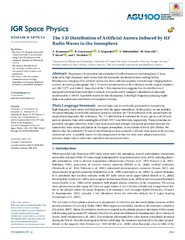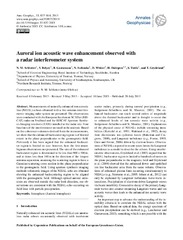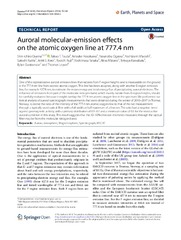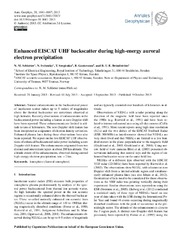Blar i forfatter "Gustavsson, Björn Johan"
-
The 3‐D Distribution of Artificial Aurora Induced by HF Radio Waves in the Ionosphere
Kvammen, Andreas; Gustavsson, Björn Johan; Sergienko, Tima; Brändström, Urban; Rietveld, Michael T; Rexer, Theresa; Vierinen, Juha (Journal article; Tidsskriftartikkel; Peer reviewed, 2019-03-21)We present 3‐D excitation rate estimates of artificial aurora in the ionospheric F layer, induced by high‐frequency radio waves from the European Incoherent Scatter heating facility. Simultaneous imaging of the artificial aurora was done with four separate Auroral Large Imaging System stations, permitting tomography‐like 3‐D auroral reconstruction of the enhanced atomic oxygen emissions at 6,300, ... -
Application of generalized aurora computed tomography to the EISCAT-3D project
Tanaka, Yoshimasa; Ogawa, Yasunobu; Kadokura, Akira; Aso, Takehiko; Gustavsson, Björn Johan; Brändström, Urban; Sergienko, Tima; Ueno, Genta; Saita, Satoko (Journal article; Tidsskriftartikkel; Peer reviewed, 2024-05-29)EISCAT_3D is a project to build a multi-site phased-array incoherent scatter radar system in northern Fenno-Scandinavia. We demonstrate via numerical simulation how useful monochromatic images taken by a multi-point imager network are for auroral research in the EISCAT_3D project. We apply the generalized aurora computed tomography (G-ACT) method to modelled observational data from real instruments, ... -
Auroral ion acoustic wave enhancement observed with a radar interferometer system
Schlatter, Nicola M.; Belyey, Vasyl; Gustavsson, Björn Johan; Ivchenko, Nickolay; Whiter, Daniel; Dahlgren, Hanna; Tuttle, Sam; Grydeland, Tom (Journal article; Tidsskriftartikkel; Peer reviewed, 2015-07-20)Measurements of naturally enhanced ion acoustic line (NEIAL) echoes obtained with a five-antenna interferometric imaging radar system are presented. The observations were conducted with the European Incoherent SCATter (EISCAT) radar on Svalbard and the EISCAT Aperture Synthesis Imaging receivers (EASI) installed at the radar site. Four baselines of the interferometer are used in the analysis. Based ... -
Auroral molecular-emission effects on the atomic oxygen line at 777.4 nm
Oyama, Shin-Ichiro; Tsuda, Takuo T.; Hosokawa, Keisuke; Ogawa, Yasunobu; Miyoshi, Yoshizumi; Kurita, Satoshi; Kero, Antti; Fujii, Ryochi; Tanaka, Yoshimasa; Mizuno, Akira; Kawabata, Tetsuya; Gustavsson, Björn Johan; Leyser, Thomas (Journal article; Tidsskriftartikkel; Peer reviewed, 2018-10-16)One of the representative auroral emission lines that radiates from F-region heights and is measurable on the ground is the 777.4 nm line from excited atomic oxygen. This line has been adopted, along with another E-region emission line, for example 427.8 nm, to estimate the mean energy and total energy flux of precipitating auroral electrons. The influence of emissions from part of the molecular ... -
Conditions for Topside Ion Line Enhancements
Rexer, Theresa; Leyser, Thomas; Gustavsson, Björn Johan; Rietveld, Michael T. (Journal article; Tidsskriftartikkel; Peer reviewed, 2021-06-17)Enhanced ion line spectra as a response to magnetic field-aligned high frequency (HF) pumping of the overdense polar ionosphere with left-handed circular polarization, can be observed at the top and bottomside F-region ionosphere under certain conditions. The European Incoherent Scatter (EISCAT) UHF radar was directed in magnetic zenith on October 18th and 19th, 2017 while stepping the pump ... -
Eastward-expanding auroral surges observed in the post-midnight sector during a multiple-onset substorm
Tanaka, Yoshimasa; Ogawa, Yasunobu; Kadokura, Akira; Partamies, Noora; Whiter, Daniel; Enell, Carl-Fredrik; Brändström, Urban; Sergienko, Tima; Gustavsson, Björn Johan; Kozlovsky, Alexander; Miyaoka, Hiroshi; Yoshikawa, Akimasa (Journal article; Tidsskriftartikkel; Peer reviewed, 2015-11-09)We present three eastward-expanding auroral surge (EEAS) events that were observed intermittently at intervals of about 15 min in the post-midnight sector (01:55–02:40 MLT) by all-sky imagers and magnetometers in northern Europe. It was deduced that each surge occurred just after each onset of a multiple-onset substorm, which was small-scale and did not clearly expand westward, because they were ... -
Electron Energy Spectrum and Auroral Power Estimation From Incoherent Scatter Radar Measurements
Virtanen, Ilkka I.; Gustavsson, Björn Johan; Aikio, Anita; Kero, Antti; Asamura, Kazushi; Ogawa, Yasunobu (Journal article; Tidsskriftartikkel; Peer reviewed, 2018-07-23)Differential energy flux of electrons precipitating into the high‐latitude ionosphere can be estimated from incoherent scatter radar observations of the ionospheric electron density profile. We present a method called ELSPEC for electron spectrum estimation from incoherent scatter radar measurements, which is based on integration of the electron continuity equation and spectrum model selection by ... -
Electron heating by HF pumping of high-latitude ionospheric F-region plasma near magnetic zenith
Leyser, Thomas B; Gustavsson, Björn Johan; Rexer, Theresa; Rietveld, Michael T (Journal article; Tidsskriftartikkel; Peer reviewed, 2020-03-06)High-frequency electromagnetic pumping of ionospheric F-region plasma at high and mid latitudes gives the strongest plasma response in magnetic zenith, antiparallel to the geomagnetic field in the Northern Hemisphere. This has been observed in optical emissions from the pumped plasma turbulence, electron temperature enhancements, filamentary magnetic field-aligned plasma density irregularities, and ... -
Enhanced EISCAT UHF backscatter during high-energy auroral electron precipitation
Schlatter, Nicola M.; Ivchenko, Nickolay; Sergienko, T; Gustavsson, Björn Johan; Brändström, B. U. E. (Journal article; Tidsskriftartikkel; Peer reviewed, 2013)Natural enhancements in the backscattered power of incoherent scatter radars up to 5 orders of magnitudes above the thermal backscatter are sometimes observed at high latitudes. Recently observations of enhancements in the backscattered power including a feature at zero Doppler shift have been reported. These enhancements are limited in altitude to tens of kilometers. The zero Doppler shift ... -
Evidence of L-mode electromagnetic wave pumping of ionospheric plasma near geomagnetic zenith
Leyser, Thomas B; James, H Gordon; Gustavsson, Björn Johan; Rietveld, Michael T (Journal article; Peer reviewed, 2018-02-21)The response of ionospheric plasma to pumping by powerful HF (high frequency) electromagnetic waves transmitted from the ground into the ionosphere is the strongest in the direction of geomagnetic zenith. We present experimental results from transmitting a left-handed circularly polarized HF beam from the EISCAT (European Incoherent SCATter association) Heating facility in magnetic zenith. The ... -
F-region electron heating by X-mode radiowaves in underdense conditions
Gustavsson, Björn Johan; Löfås, H.; Ivchenko, N.; Rietveld, Michael T; Leyser, T. B. (Journal article; Tidsskriftartikkel; Peer reviewed, 2009) -
First estimates of volume distribution of HF-pump enhanced emissions at 6300 and 5577 Å : a comparison between observations and theory
Gustavsson, Björn Johan; Kosch, Mike; Wong, Alfred; Pedersen, Todd; Heinselman, Craig; Mutiso, Charles; Bristow, Bill; Hughes, John; Wang, Weiyuan (Journal article; Tidsskriftartikkel; Peer reviewed, 2008)We present bi-static observations of radio-wave induced optical emissions at 6300 and 5577 Å from a night-time radio-induced optical emission ionospheric pumping experiment at the HIPAS (Fairbanks) facility in Alaska. The optical observations were made at HIPAS and from HAARP located 285 km south-east. From these observations the altitude distribution of the emissions is estimated with tomography-like ... -
First Observations of Recurring HF-Enhanced Topside Ion Line Spectra Near the Fourth Gyroharmonic
Rexer, Theresa; Gustavsson, Björn Johan; Leyser, Thomas; Rietveld, Michael T; Yeoman, Tim; Grydeland, Tom (Journal article; Tidsskriftartikkel; Peer reviewed, 2018-09-28)We present first incoherent scatter radar observations of systematically recurring, high‐frequency (HF)‐enhanced ion line spectra at the topside F‐region ionosphere, during magnetic field aligned HF pumping in an O‐mode polarization. The European Incoherent Scatter UHF radar was directed in magnetic zenith on 9–11 March 2016 while stepping the pump frequency across the double resonance of the fourth ... -
Horizontal electric fields from flow of auroral O+(2P) ions at sub-second temporal resolution
Tuttle, Sam; Lanchester, Betty; Gustavsson, Björn Johan; Keith Whiter, Daniel; Ivchenko, Nickolay; Fear, R. C.; Lester, Mark (Journal article; Tidsskriftartikkel; Peer reviewed, 2020-07-14)Electric fields are a ubiquitous feature of the ionosphere and are intimately linked with aurora through particle precipitation and field-aligned currents. They exhibit order-of-magnitude changes on temporal and spatial scales of seconds and kilometres respectively which are not easy to measure; knowing their true magnitude and temporal variability is important for a theoretical understanding of ... -
Lightboard – a new teaching tool at the Faculty of Science and Technology at UiT
Malyutina, Elena; Gustavsson, Björn Johan; Vierinen, Juha; Tveito, Torbjørn (Journal article; Tidsskriftartikkel; Peer reviewed, 2021-05-05)We would like to present a new tool that was built by three lecturers at UiT last semester – Lightboard. This tool was used before in other countries and other universities, but never at UiT. The COVID-19 pandemic situation motivated the lecturers to find a way to do online lectures differently. Blackboard and chalk work well for natural sciences as long as the lecture is physical and the teacher ... -
Lumikot: Fast auroral transients during the growth phase of substorms
McKay, Derek; Paavilainen, Tuula; Gustavsson, Björn Johan; Kvammen, Andreas; Partamies, Noora (Journal article; Tidsskriftartikkel; Peer reviewed, 2019-06-25)The development of a magnetospheric substorm may be classified into three phases: growth, expansion, and recovery. The growth phase is important as it includes processes that lead to the expansion. In a recent growth-phase study, a type of fast discrete auroral transient phenomena -- referred to as Lumikot -- were observed. The Lumikot are several kilometers across and move in the high-energy ... -
A new auroral phenomenon, the anti-black aurora
Nel, A.E.; Kosch, M.J.; Keith Whiter, Daniel; Gustavsson, Björn Johan; Aslaksen, Torun Helene (Journal article; Tidsskriftartikkel; Peer reviewed, 2021-01-19)Black auroras are small-scale features embedded in the diffuse background aurora, typically occurring post-substorm after magnetic midnight and with an eastward drift imposed. Black auroras show a significant reduction in optical brightness compared to the surrounding diffuse aurora, and can appear as slow-moving arcs or rapidly-moving patches and arc segments. We report, for the first time, an even ... -
NOIRE-Net–a convolutional neural network for automatic classification and scaling of high-latitude ionograms
Kvammen, Andreas; Vierinen, Juha-Pekka; Huyghebaert, Devin Ray; Rexer, Theresa; Spicher, Andres; Gustavsson, Björn Johan; Floberg, Jens (Journal article; Tidsskriftartikkel, 2024-06-03)Millions of ionograms are acquired annually to monitor the ionosphere. The accumulated data contain untapped information from a range of locations, multiple solar cycles, and various geomagnetic conditions. In this study, we propose the application of deep convolutional neural networks to automatically classify and scale high-latitude ionograms. A supervised approach is implemented and the networks ... -
Observations of HF-induced instability in the auroral E region
Schlatter, Nicola M.; Ivchenko, Nickolay; Gustavsson, Björn Johan; Leyser, Thomas; Rietveld, Michael T (Journal article; Tidsskriftartikkel; Peer reviewed, 2013)Enhancements were observed in backscattered radar power during an ionospheric heating experiment from two distinct altitude regions in the auroral E region above Tromsø. For the experiment the EISCAT Tromsø heater was operated with O mode and X mode alternated at 4.04 MHz, close to the 3rd electron gyroharmonic. Ion-line data recorded with the EISCAT UHF radar reveal different temporal ... -
On mechanisms for high-frequency pump-enhanced optical emissions at 557.7 and 630.0gnm from atomic oxygen in the high-latitude F-region ionosphere
Leyser, Thomas B.; Sergienko, Tima; Brändström, Urban; Gustavsson, Björn Johan; Rietveld, Michael T. (Journal article; Tidsskriftartikkel; Peer reviewed, 2023-12-13)The EISCAT (European Incoherent Scatter Scientific Association) Heating facility was used to transmit powerful high-frequency (HF) electromagnetic waves into the Fregion ionosphere to enhance optical emissions at 557.7 and 630.0 nm from atomic oxygen. The emissions were imaged by several stations of ALIS (Auroral Large Imaging System) in northern Sweden, and the EISCAT UHF incoherent scatter radar ...


 English
English norsk
norsk


















